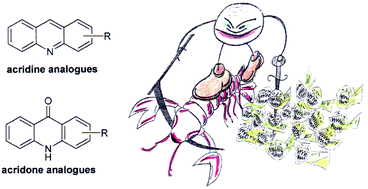Recent developments in the synthesis and biological activity of acridine/acridone analogues
Abstract
Many people in the world struggle with cancer or bacterial, parasitic, viral, Alzheimer's and other diseases. Therefore, many scientists seek new, more effective, more selective and less toxic drugs. Acridine/acridone derivatives constitute a class of compounds with a broad spectrum of biological activity and are of great interest to scientists. To date, many acridine/acridone analogues have been obtained, which, inter alia, exhibit antitumour (e.g., (1–5)), antimicrobial (e.g., (59)), and antiviral (e.g., (61)) activities and are applicable in the treatment of Alzheimer's disease (e.g., (26)). However, in many cases, their clinical application is limited and excluded because of side effects. In this survey, we describe acridine and acridone derivatives reported since 2013, methods of their synthesis and their potential clinical applications.

- This article is part of the themed collections: Drug design and discovery, 2017 Review articles and RSC Advances: Most downloaded articles of 2017


 Please wait while we load your content...
Please wait while we load your content...